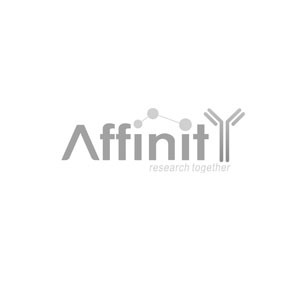CEACAM5 Antibody - #DF6152
| Product: | CEACAM5 Antibody |
| Catalog: | DF6152 |
| Description: | Rabbit polyclonal antibody to CEACAM5 |
| Application: | WB IHC |
| Reactivity: | Human, Mouse, Rat |
| Mol.Wt.: | 77kDa; 77kD(Calculated). |
| Uniprot: | P06731 |
| RRID: | AB_2838119 |
Related Downloads
Protocols
Product Info
*The optimal dilutions should be determined by the end user.
*Tips:
WB: For western blot detection of denatured protein samples. IHC: For immunohistochemical detection of paraffin sections (IHC-p) or frozen sections (IHC-f) of tissue samples. IF/ICC: For immunofluorescence detection of cell samples. ELISA(peptide): For ELISA detection of antigenic peptide.
Cite Format: Affinity Biosciences Cat# DF6152, RRID:AB_2838119.
Fold/Unfold
Carcinoembryonic antigen; Carcinoembryonic antigen-related cell adhesion molecule 5; CD66e; CEA; Ceacam5; CEAM5_HUMAN; DKFZp781M2392; Meconium antigen 100; OTTHUMP00000199032; OTTHUMP00000199033; OTTHUMP00000199034;
Immunogens
Expressed in columnar epithelial and goblet cells of the colon (at protein level) (PubMed:10436421). Found in adenocarcinomas of endodermally derived digestive system epithelium and fetal colon.
- P06731 CEAM5_HUMAN:
- Protein BLAST With
- NCBI/
- ExPASy/
- Uniprot
MESPSAPPHRWCIPWQRLLLTASLLTFWNPPTTAKLTIESTPFNVAEGKEVLLLVHNLPQHLFGYSWYKGERVDGNRQIIGYVIGTQQATPGPAYSGREIIYPNASLLIQNIIQNDTGFYTLHVIKSDLVNEEATGQFRVYPELPKPSISSNNSKPVEDKDAVAFTCEPETQDATYLWWVNNQSLPVSPRLQLSNGNRTLTLFNVTRNDTASYKCETQNPVSARRSDSVILNVLYGPDAPTISPLNTSYRSGENLNLSCHAASNPPAQYSWFVNGTFQQSTQELFIPNITVNNSGSYTCQAHNSDTGLNRTTVTTITVYAEPPKPFITSNNSNPVEDEDAVALTCEPEIQNTTYLWWVNNQSLPVSPRLQLSNDNRTLTLLSVTRNDVGPYECGIQNKLSVDHSDPVILNVLYGPDDPTISPSYTYYRPGVNLSLSCHAASNPPAQYSWLIDGNIQQHTQELFISNITEKNSGLYTCQANNSASGHSRTTVKTITVSAELPKPSISSNNSKPVEDKDAVAFTCEPEAQNTTYLWWVNGQSLPVSPRLQLSNGNRTLTLFNVTRNDARAYVCGIQNSVSANRSDPVTLDVLYGPDTPIISPPDSSYLSGANLNLSCHSASNPSPQYSWRINGIPQQHTQVLFIAKITPNNNGTYACFVSNLATGRNNSIVKSITVSASGTSPGLSAGATVGIMIGVLVGVALI
PTMs - P06731 As Substrate
| Site | PTM Type | Enzyme | Source |
|---|---|---|---|
| T199 | Phosphorylation | Uniprot | |
| T201 | Phosphorylation | Uniprot | |
| T206 | Phosphorylation | Uniprot | |
| Y213 | Phosphorylation | Uniprot | |
| S226 | Phosphorylation | Uniprot | |
| N246 | N-Glycosylation | Uniprot | |
| S404 | Phosphorylation | Uniprot | |
| T419 | Phosphorylation | Uniprot | |
| S421 | Phosphorylation | Uniprot | |
| T476 | Phosphorylation | Uniprot | |
| N560 | N-Glycosylation | Uniprot | |
| S680 | Phosphorylation | Uniprot |
Research Backgrounds
Cell surface glycoprotein that plays a role in cell adhesion, intracellular signaling and tumor progression. Mediates homophilic and heterophilic cell adhesion with other carcinoembryonic antigen-related cell adhesion molecules, such as CEACAM6. Plays a role as an oncogene by promoting tumor progression; induces resistance to anoikis of colorectal carcinoma cells.
(Microbial infection) Receptor for E.coli Dr adhesins. Binding of E.coli Dr adhesins leads to dissociation of the homodimer.
Complex immunoreactive glycoprotein with a MW of 180 kDa comprising 60% carbohydrate.
Cell membrane>Lipid-anchor. Apical cell membrane. Cell surface.
Note: Localized to the apical glycocalyx surface.
Expressed in columnar epithelial and goblet cells of the colon (at protein level). Found in adenocarcinomas of endodermally derived digestive system epithelium and fetal colon.
Homodimer.
Belongs to the immunoglobulin superfamily. CEA family.
References
Application: IHC Species: mouse Sample: lung cancer
Restrictive clause
Affinity Biosciences tests all products strictly. Citations are provided as a resource for additional applications that have not been validated by Affinity Biosciences. Please choose the appropriate format for each application and consult Materials and Methods sections for additional details about the use of any product in these publications.
For Research Use Only.
Not for use in diagnostic or therapeutic procedures. Not for resale. Not for distribution without written consent. Affinity Biosciences will not be held responsible for patent infringement or other violations that may occur with the use of our products. Affinity Biosciences, Affinity Biosciences Logo and all other trademarks are the property of Affinity Biosciences LTD.

